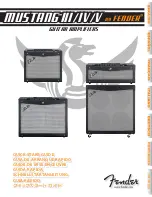
•
Burned spot on the large gray structure inside the tube.
Sometimes a output tube or preamp tube will become “microphonic” when something
becomes physically loose inside the tube's glass envelope. In turn, this noise then gets
amplified through the speaker. The noise can be anything from static, a high-pitched ringing,
or intermittent sputtering noises. This is usually exacerbated by vibration from the speaker
cabinet. If you think a tube may be microphonic, try isolating the amplifier from the speaker
cabinet.
Tip: If you think you have a microphonic tube, you can very gently tap on each tube with a pencil's
eraser to see if the sound becomes worse or changes. All tubes will amplify the sound a little,
especially preamp tubes. But for example, if you hear an intermittent ringing sound and tap each
tube to find V9 is causing the ringing to start and stop, you can be sure it's the problematic tube!
In general preamp (V9, V8, V7), phase inverter (V6), and effects loop (V5) tubes (see tube
chart on pg. 12) can last many years, and usually become microphonic before wearing out or
failing.
Changing preamp, effects loop, and phase inverter tubes
V5, V6, V7, V8, and V9 (see tube chart on pg. 12)
Push down and gently twist remove the aluminum shields over the preamp, etc. tubes. To
remove tubes, gently pull upward using a very slight circular motion if necessary. When re-
inserting a preamp tube, mind the pin/socket orientation as they are “keyed” to insure proper
installation.
Changing output tubes
V1, V2, V3, and V4 (see tube chart on pg. 12)
CAUTION!: Tubes can become extremely hot during normal operation. Make sure the
amplifier is OFF, and always allow tubes to cool before handling to prevent burns.
In general, it's best to change all 4 output tubes at once (V1, V2, V3, and V4 – See tube chart on
pg. 12), and preferable to buy a "matched quad" from a reputable dealer. However, because of
the dual-bias system, it is possible to replace only one pair of output tubes with a "matched
pair," then balancing the bias level with the old pair.
Tip: Buy “burned-in” tubes when possible for maximum stability and minimal bias drift.
To change tubes, remove the old tubes and set both bias controls all the way down (counter-
clockwise). Insert the new tubes minding the “key” on the bottom of the tube, and slowly
bring up both bias controls until they are equal and in the safe bias range.
If tubes are not pre-“burned-in,” check the bias after playing to see if it has drifted from the
initial setting. Full burn-in may take up to 24 hours depending on the tube set. This is why
8
Summary of Contents for DECOLONIZER
Page 1: ...1...






























